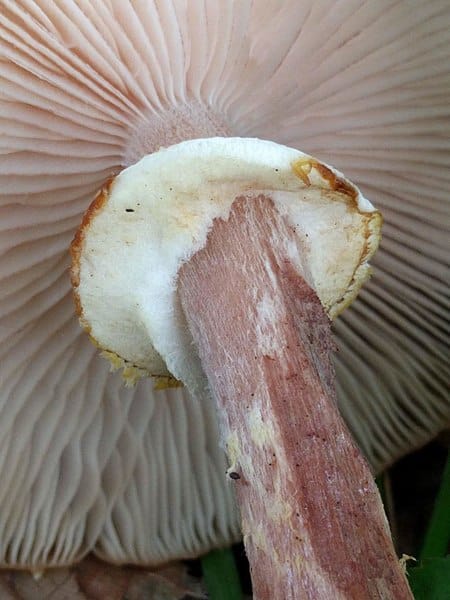Honey Fungus Identification – Armillaria mellea
Heads up
The Honey Fungus doesn’t just get its name from its color; it’s also sweet-tasting. However, it’s not all sweetness. It can cause Armillaria root rot. That’s a type of disease that affects plants. Trees that get infected by this fungus will show signs like their leaves changing color or branches dying. A fun fact about Honey Fungus is that the thread-like parts of the fungus underground, known as mycelium, can glow in the dark when they are growing.
Honey Fungus: Key Parts in Photos




How to identify Honey Fungus
When you’re out mushroom hunting, here’s what to look out for:
- Cap: The top part of the mushroom, or the cap, is sticky when it’s wet. It can be between 1-6 inches wide. When young, it’s convex in shape, and as it grows, it becomes flat, sometimes even looking a bit like a shallow bowl. The color is just like honey. Sometimes, in the center, there might be some dark scales that look like little hairs.
- Gills: Underneath the cap, you’ll find the gills. They start off white and may turn a pinkish-yellow as they age. These gills are how the mushroom releases its spores.
- Stipe (or Stem): The stipe is quite long, sometimes up to 8 inches, and has a sort of fibrous feel. At the top, it’s white, but it turns brownish-yellow at the bottom. The very bottom might be very dark. Something special about the Honey Fungus is its ring. This ring was once a veil that protected the gills when the mushroom was young.
- Taste and Smell: The inside of the Honey Fungus is white. It smells and tastes sweet but might have a slight bitter touch.
- Spore Print: The spore print of Honey Fungus is print. Under a microscope, these spores look like tiny ovals with a small pointy bit at the bottom.
- Mycelium: Beneath the soil, the Honey Fungus spreads out in threads, forming a net called mycelium. They sometimes group together to form black structures called rhizomorphs. The Honey Fungus Mycelium can glow in the dark when growing.
Want to learn more?

Disclosure: This post includes affiliate links. If you make a purchase through these links, we may earn a commission at no extra cost to you. We appreciate your support, as it helps keep this website running. Alternatively, you can search for the book title on Amazon if you prefer not to use the links. Thank you for your understanding and support!
